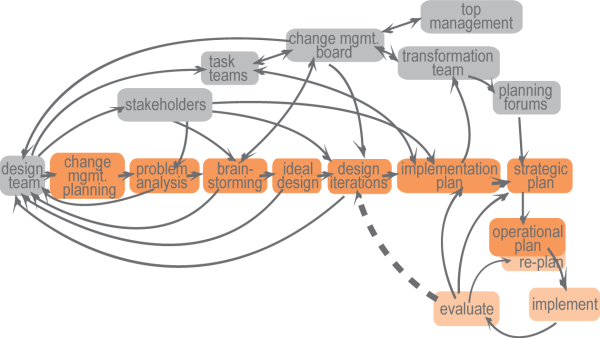systemic change management
The video below is of Dr. Elisabeth Dostal’s talk given to the students of the School of Management at the University of Cape Town. Dr. Dostal explains some of the key concepts of general and Biomatrix systems theory and reflects on their implication for systemic change management. Amongst others, she discusses why so many change interventions fail, explains how three-dimensional organisational matrix works, and outlines systemic change management methodology.
You can also download the slides of the presentation by clicking on the button below.
The Biomatrix approach to change management is not based on any traditional change management model but it is derived from a complete and coherent systemic framework.
To gain thorough understanding of our approach, managers should also study the concepts of seven systems forces and ideal future.
system redesign
The redesign of a system is iterative and involves various phases as well as different change management structures.
the phases are the following:
- preparation phase (involving diagnosis, planning the intervention, identifying and enrolling stakeholders, amongst others)
- design phase (involving problem identification, brainstorming, compiling a design notebook and creation of the design)
- design iteration phase (ensuring alignment of stakeholders with the design)
- implementation planning phase (making an implementation plan for the design)
- implementing the plan by integrating it with the current strategic plan of the system and cascading it throughout the system involving the relevant planning forums. (If the redesign involves a restructuring of the organisation, new planning forums may have to be set up according to the new organisational structure.)
As new information is generated in a phase, it could be necessary to iterate back to the previous phase for generating new or different output.
Each phase in change management process is facilitated by various change management teams (e.g. a design team, various task teams and a transformation team) coordinated by a change management board which ensures coordination and continuity and also keeps top management informed throughout the intervention.
The intervention is complete when the strategies associated with the new design have become part of the ongoing performance of the system.

fig: phases in change management process
Systemic change needs to be prepared, designed, planned and facilitated by involving relevant stakeholders.
The change process is as important as its outcome. Ideally, it changes the mindsets of relevant stakeholders, making implementation of the change much easier.
Our approach enforces that the process is facilitated in a learning manner and stakeholders are appropriately involved (e.g. through participation and regular feedback).
clockwise and counterclockwise change (3:29)
about biomatrixweb
BiomatrixWeb offers education and development programmes guiding the client organisation to seamlessly transform itself into a learning organisation structured as a three-dimensional matrix.
learn more
To learn more about Biomatrix systems theory in general, visit biomatixtheory.com and browse the free presentation.
To learn more about application of Biomatrix systems theory to organisational development and change management, consider purchasing one of our books, or facilitate one of our management education courses or development programmes in your organisation.


